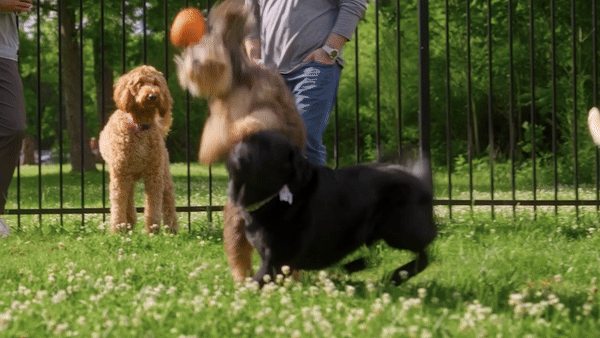Nom Nom Blog
A Guide to Exercising Your Dog's Mind
Mental exercise is key to a dog’s overall health and happiness. It prevents boredom, improves cognitive function, and creates an opportunity to bond with their favorite people. Dogs are social animals after all, with a particular penchant for solving problems —such as making up for an unacceptable lack of treats.
WHY DOGS REQUIRE MENTAL STIMULATION
Dogs thrive on routine, love learning new things, and enjoy challenges that engage their senses, which makes mental stimulation a vital component of their holistic care.
Preventing Boredom
Just like humans, dogs can experience boredom due to a lack of variety and stimulation. Think about the various ways you react when YOU'RE not properly engaged...it can easily lead to anything from depression and anxiety to manic behaviors. Which may or may not include chewing holes in the couch.
Mental Health
Engaging a dog's mind keeps them mentally sharp and alert. They're often calmer, more content, and less prone to anxiety or stress-related behaviors (see above).
Curbing Desctructive Behavior
Providing mental stimulation helps redirect a dog's energy towards constructive activities, rather than destructive ones (again, above).
Physical Health
Many mental stimulation activities, such as agility training or interactive play, also provide physical exercise, which is crucial for a dog's physical health and fitness.
Bonding and Communication
Training sessions, interactive games, and problem-solving activities provide opportunities for communication, cooperation, and positive reinforcement, deepening the relationship between you and your dog.
Cognitive Function
Dogs can experience cognitive decline as they age. Mental stimulation throughout their lives can help maintain healthy brain activity and delay the onset of cognitive dysfunction syndrome (similar to Alzheimer's disease in humans).
KEY PRINCIPLES OF MENTAL STIMULATION FOR DOGS
Keep these four fundamentals in mind when introducing enrichment activities for your pup.
Variety
Introduce a range of activities to prevent monotony and keep your dog interested.
Positive Reinforcement
Use treats, praise, and play to reward desired behaviors, and make learning enjoyable for your dog.
Patience
Every dog learns at their own pace. Be patient and encouraging throughout the training process.
Consistency
Create positive habits by using routines to reinforce learning and behavior.
ACTIVITIES TO WORK OUT YOUR DOG'S MIND
From fun backyard games to regimented training, there are all sorts of ways to keep your pup engaged.
Puzzle Toys
Interactive puzzle toys challenge your dog's problem-solving skills. Treats are hidden inside (sometimes locked) compartments, that your dog must figure out how to access.
Brain Games
Create your own brain teasers by hiding treats under cups or blankets and encouraging your dog to find them. You can also teach your dog to differentiate between toys or objects based on verbal cues.
Interactive Play
Engage your dog in games like fetch, tug-of-war, or hide-and-seek, to provide physical and mental exercise and cement your parent-pup bond.
Playdates & Socializaiton
Just like with human kids, socialization and interaction is an absolute must for a mentally and emotionally balanced dog.
Obedience / Behavioral Training
In addition to basic commands such as sit, stay, and come, you can raise the stakes by incorporating distractions or teaching more advanced tricks.
Scent Work
Dogs have an incredible sense of smell, making scent-based activities highly stimulating. Hide treats or toys around the house or yard and encourage your dog to find them using their nose.
Agility Courses
Set up a mini agility course in your backyard using cones, tunnels, and hurdles. Guide your dog through the course, rewarding them for completing each obstacle.
Daily Walks in New Environment
We're not just talking about that same-old jaunt around the block. Taking your dog for walks in different environments exposes them to new sights, sounds, and smells.
INCORPORATING MENTAL STIMULATION INTO YOUR DOG'S DAILY ROUTINE
By strategically integrating mental stimulation into various junctures of your dog's daily routine, you can ensure they remain fulfilled, content, and cognitively enriched throughout the day.
Morning
Greet the day with short training sessions or a game of fetch to kickstart their cognitive functions and ready your dog for the day ahead.
Midday
Once your dog's physical energy levels have dipped, it's a great time to introduce puzzle toys or interactive feeders that challenge their problem-solving skills while providing entertainment and mental engagement.
Evening
Go for a leisurely walk in a new environment, or tap into your dog's natural instincts by introducing scent work activities before winding down for the night.
Transition Periods
Incorporating mental stimulation during transition periods, such as before mealtime or when you leave the house, can help alleviate boredom and separation anxiety.
So when taking care of your dog's whole-body health, from embarking on daily hikes to feeding them top-quality, nutritionally-balanced food, don't forget to exercise their mind. Your pup (and couch) will thank you for it.




